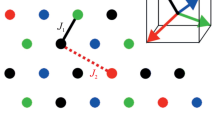Abstract
We calculate the partition function of the q-state Potts model on arbitrary-length cyclic ladder graphs of the square and triangular lattices, with a generalized external magnetic field that favors or disfavors a subset of spin values \(\{1,\ldots ,s\}\) with \(s \le q\). For the case of antiferromagnet spin–spin coupling, these provide exactly solved models that exhibit an onset of frustration and competing interactions in the context of a novel type of tensor-product \(S_s \otimes S_{q-s}\) global symmetry, where \(S_s\) is the permutation group on s objects.
Similar content being viewed by others
References
Shrock, R.: Exact Potts model partition functions for ladder graphs. Physica A 283, 388–446 (2000)
Chang, S.-C., Shrock, R.: Exact Potts model partition functions on strips of the triangular lattice. Physica A 286, 189–238 (2000)
Chang, S.-C., Shrock, R.: Structure of the partition function and transfer matrices for the Potts model in a magnetic field on lattice strips. J. Stat. Phys. 137, 667–699 (2009)
Chang, S.-C., Shrock, R.: Weighted graph colorings. J. Stat. Phys. 138, 496–542 (2010)
Wreszinski, W.F., Salinas, S.R.A.: Disorder and Competition in Soluble Lattice Models. World Scientific, Singapore (1993)
Wu, F.Y.: Percolation and the Potts model. J. Stat. Phys. 18, 115–123 (1978)
Wu, F.Y.: The Potts model. Rev. Mod. Phys. 54, 235–268 (1982)
Chang, S.-C., Shrock, R.: Some exact results on the Potts model partition function in a magnetic field. J. Phys. A 42, 385004 (2009)
Shrock, R., Xu, Y.: Weighted set graph colorings. J. Stat. Phys. 139, 27–61 (2010)
Shrock, R., Xu, Y.: Exact results on Potts model partition functions in a generalized external field and weighted-set graph colorings. J. Stat. Phys. 141, 909–939 (2010)
Tutte, W.T.: A ring in graph theory. Proc. Camb. Philos. Soc. 43, 26–40 (1947)
Tutte, W.T.: On dichromatic polynomials. J. Combin. Theory 1, 301–320 (1967)
Biggs, N.: Algebraic Graph Theory. Cambridge University Press, Cambridge (1993)
Bollobás, B.: Modern Graph Theory. Springer, New York (1998)
Chang, S.-C., Shrock, R.: Exact Potts model partition functions on wider arbitrary-length strips of the square lattice. Physica A 296, 234–288 (2001)
Shrock, R., Tsai, S.-H.: Complex-temperature phase diagrams of 1D spin models with next-nearest-neighbor couplings. Phys. Rev. E 55, 5184–5193 (1997)
Acknowledgments
This research was partly supported by the Taiwan Ministry of Science and Technology Grant MOST 103-2918-I-006-016 (S.-C.C.) and by the U.S. National Science Foundation Grant No. NSF-PHY-13-16617 (R.S.).
Author information
Authors and Affiliations
Corresponding author
Additional information
Shu-Chiuan Chang is on sabbatical leave with the C. N. Yang Institute for Theoretical Physics and Department of Physics and Astronomy, Stony Brook University, Stony Brook, NY, 11794.
Appendices
Appendix 1: \(Z(sq,2 \times m,cyc.,q,v)\)
We review here the result for the partition function \(Z(sq,2 \times m,cyc.,q,v)\) of the cyclic square-lattice ladder graph of length \(L_x=m\) vertices presented in [1]. We include this in connection with our discussion in the text showing how our new result for \(Z(sq,2 \times m,cyc.,q,s,v,w)\) reduces to \(Z(sq,2 \times m,cyc.,q,v)\) in the zero-field case \(w=1\). This partition function has the form of
with \(L_y=2\), where \(n_Z(2,0)=2\), \(n_Z(2,1)=3\), \(n_Z(2,2)=1\), and the coefficients \(c^{(d)}\) are given in Eq. (3.2), so
As is evident in Eq. (8.1), to distinguish the \(\lambda _{sq,2,d,j}\)s in the zero-field partition function \(Z(sq,2 \times m,q,v)\) from the \(\lambda _{Z,sq,2,d,j}\) in the field-dependent partition function \(Z(sq,2\times m,q,s,v,w)\), we suppress the subscript Z in the former. Explicitly,
where (in order of decreasing d) \(\lambda _{sq,2,2}=v^2\),
and
where
and
The reader is referred to [2] for our corresponding solution for the partition function \(Z(tri,2 \times m,cyc.,q,v)\) of the cyclic triangular-lattice ladder graph of arbitrary length.
Appendix 2: \(T_{Z,sq,2,0}\)
Five of the \(s^2+2s+2\) \(\lambda _{Z,sq,2,0,j}\) terms, each with multiplicity 1, are determined as the roots of a quintic equation which is the characteristic polynomial of the transfer matrix \(T_{Z,sq,L_y,d}\) with \(L_y=2\), \(d=0\), and the following entries:
Appendix 3: Matrices \(T_{Z,tri,2,d}\) for \(d=1\), \(d=0\)
1.1 \(d=1\)
Five of the \(s^2+2s+2\) \(\lambda _{Z,tri,2,1,j}\) terms, each with multiplicity 1, are determined as the roots of a quintic equation which is the characteristic polynomial of the matrix \(T_{Z,tri,L_y,d}\) with \(L_y=2\), \(d=1\), and the following entries:
1.2 \(d=0\)
Five of the \(\lambda _{Z,tri,L_y,d,j}\) with \(L_y=2\) and \(d=0\) are the roots, each with multiplicity \(s-1\), of a quintic equation which is the characteristic polynomial of the transfer matrix \(T_{Z,tri,2,0a}\). This matrix may be obtained from \(T_{Z,tri,2,1}\) by the replacements \(s \rightarrow q-s\) and \(w \rightarrow w^{-1}\) and then multiplication by \(w^2\).
Six of the \(\lambda _{Z,tri,L_y,d,j}\) with \(L_y=2\) and \(d=0\) are the roots, each with multiplicity 1, of a degree-6 equation which is the characteristic polynomial of the matrix \(T_{Z,tri,2,0b}\) with entries
Rights and permissions
About this article
Cite this article
Chang, SC., Shrock, R. Exact Partition Functions for the q-State Potts Model with a Generalized Magnetic Field on Lattice Strip Graphs. J Stat Phys 161, 915–932 (2015). https://doi.org/10.1007/s10955-015-1357-z
Received:
Accepted:
Published:
Issue Date:
DOI: https://doi.org/10.1007/s10955-015-1357-z




